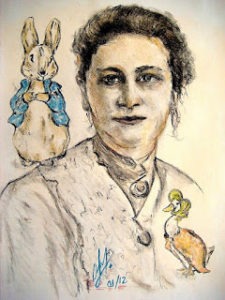
When Beatrix Potter was young she spent many happy holidays in Scotland and the Lake District. It was on these long summer holidays that she developed a love of animals and nature and grew great inspiration for her art.
She was very observant of all things in nature and began sketching insects, animals and plants with great accuracy.
Beatrix’s education was sadly lacking. She had not been given the opportunity of the kind of education that her brother had enjoyed but she was able to gain her Second Grade Art Student Certificate at the National Art Training School in South Kensington. However her main source of learning as far as drawing was concerned came from drawing manuals and books. She also studied the works of Thomas Gainsborough, M.W.Turner. and John Constable
As she grew older she taught herself to draw with one eye to a microscope and this led to her becoming interested in fungi which in turn led to her being asked by the Royal Botanic Gardens in Kew to study fungi. At this time she drew hundreds of botanical illustrations which were very detailed and she became interested in the cultivation and growth of fungi. She worked at making her drawings technically accurate and began using water colours in her work. This eventually led to her establishing herself as a worthy scientific illustrator. Her abilities as an adept Illustrator enabled her to gain a modest income whilst continuing her research on fungi.
In the late 1890’s The Linnean Society rejected a paper she had written on “The Germination of the Spores of Agaricineae”. It was then that she decided to devote her time to drawing and painting.
The Norman Rockwell Museum states:
“Beatrix’s illustration career started from humble beginnings, with drawings of some of her favorite stories. She illustrated her own versions of Alice’s Adventures in Wonderland and Cinderella, and as always, avidly drew from nature. These works led to her first publishing opportunity with Hildesheimer & Faulkner in 1890, when her art was utilized for greeting card designs and book illustrations. A series of frog illustrations and contributions to Changing Pictures, an annual with art publisher Ernest Nister, soon followed which bolstered Beatrix’s ambition to publish her own illustrated stories”.
This opportunity came a few weeks later. She had previously sent a letter to Noel, son of her former Governess, Anne Moore, in which she had written a story about Peter the Rabbit. This included very detailed illustrations. In 1900 she borrowed the illustrations from Noel and sought to copy them to be included in her first published work “The Tale of Peter Rabbit”
Initially her work was rejected by six publishers so she decided to publish the book herself. Immediately her book became a success and it was not long before Frederick Warne & Co., one of the publishers who had rejected Beatrix reconsidered their decision and offered to Publish the work. First though, they asked Beatrix to produce the illustrations in colour.
The book became an instant best seller when it was published in 1902.
Beatrix almost immediately recognised a merchandising opportunity, (she had already designed and sewn a Peter Rabbit doll for a young Niece of Norman Warne) and registered her designs at the Patent Office thus making “Peter Rabbit” the world’s earliest licensed literary character.
At the time of writing (2019) the V & A (Victoria and Albert) Museum holds the world’s largest collection of Beatrix Potter’s drawings as well as correspondence, manuscripts and other materials.
You can view some of the collection if you visit the V & A website and follow the “search the collections” link.
Illustration: Beatrix Potter, 2012 – Olivia Waste
